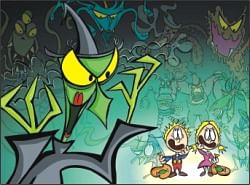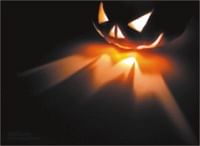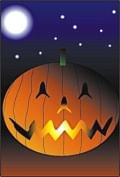
By Niloy
The good
old Celts
It all began in what is now France and the British Isles. It was started
by the Celtic people long ago....
 The
Celts believed that when people died, they went to a land of eternal
youth and happiness called Tir nan Og. They did not have the concept
of heaven and hell that the Christian church later brought into the
land. The dead were sometimes believed to be dwelling with the Fairy
Folk, who lived in the numerous mounds or sidhe (pron. "shee")
that dotted the Irish and Scottish countryside.
The
Celts believed that when people died, they went to a land of eternal
youth and happiness called Tir nan Og. They did not have the concept
of heaven and hell that the Christian church later brought into the
land. The dead were sometimes believed to be dwelling with the Fairy
Folk, who lived in the numerous mounds or sidhe (pron. "shee")
that dotted the Irish and Scottish countryside.
Samhain was the
New Year to the Celts. In the Celtic belief system, turning points,
such as the time between one day and the next, the meeting of sea
and shore, or the turning of one year into the next were seen as magickal
times. The turning of the year was the most potent of these times.
This was the time when the "veil between the worlds" was
at its thinnest, and the living could communicate with their beloved
dead in Tir nan Og.
The Celtic people
feared the night of October 31. It was the night of their festival
of Samhain, Lord of the Dead. The Celtics feared Samhain and in order
to please him, the Druids (Celtic priests) held cruel fire rites in
his honour. They made huge bonfires every year at this time. The bonfires
were usually made of oak and considered sacred.
At this festival,
the Druids made sacrifices to the gods. They burned criminals, prisoners,
and animals alive. By observing the victims die, the Druids saw omens
of the future, both good and bad. The powers to make predictions of
the future were thought to be strongest on this night. Why? It was
because the Druids believed that the spirits were allowed to roam
free on this night of the year. The Druids believed the spirits were
powerful and wild on this night, and if they were treated right, they
would help with predictions of the future. However, if the spirits
were ignored, they would punish the Celtic community.
The costumes
and the treats
The Druids believed that, above powerful and wild, some spirits were
evil. This is why the Celtic people wore costumes during the Samhain
festival. The purpose of the costumes was to frighten the spirits.
Plus, this way, the spirits wouldn't be able to recognize them.
(This is the origin of costumes.)
To please the spirits, the Celtic people left food outside their houses
on Halloween. If any hungry spirits came by, they could take the food
and leave the Celtics in peace.
(This is the origin of 'trick or treat'-ing.)
 Traditions,
Myths and Legends
Traditions,
Myths and Legends
There are many folk traditions associated with Halloween. It is possible
that some had their origins in Celtic times.
Jack-o'-lantern:
The term "Jack-o'-lantern" came from an Irish folk tale
of the 18th century. Jack was an Irishman. He had tricked the Devil
into climbing an apple tree. He then cut a cross symbol in the tree
trunk, thus trapping the Devil in the branches. At his death, he was
unable to again access to Heaven because of his meanness. The Devil,
having a long memory, would not allow him into Hell. So he was forced
to walk the earth endlessly. The devil took pity on him and gave him
a piece of coal to light his path. Jack put it inside a hollowed-out
turnip that he had been eating.
Don't
mess with apples!
Apples were considered have long been associated with female deities,
and with immortality, resurrection, and knowledge. One reason is that
if an apple is cut through its equator, it will reveal a five-pointed
star outlined at the centre of each hemisphere. This was a pentagram
-- a Goddess symbol among the Roma (Gypsies), Celts, Egyptians, etc.
There are many Halloween folk traditions associated with apples:
Unmarried people
would attempt to take a bite out of an apple bobbing in a pail of
water, or suspended on a string. The first person to do so was believed
to be the next to marry.
Peeling an apple
in front of a candle-lit mirror was believed to produce the image
of one's future spouse.
Attempting to
produce a long unbroken apple peel was said to estimate the number
of years you had to live. The longer the peel, the longer your life
expectancy.
Modern
appeal
We are also sometimes governed by bad instincts, stealing, killing
or doing whatever harm. One of the best ways, one that has worked
for thousands of years, is to express them harmlessly by acting them
out in simulation or in play. This recognition of the worst in us
seems to lessen its power. The ancient Greeks called this catharsis.
Our
worst selves must be recognized in order to be controlled. Now, more
than ever, we need to fill our streets with ghosts and goblins, lurid
skeletons and other horrifying incarnations of evil.
Halloween
is here
By Kavita Charanji
 Come
October 31, and Halloween is on us once again. In this American festival,
children dress up in costumes and go trick-or-treating. Many people
carve jack-o-lanterns out of pumpkins. Halloween parties feature such
traditional activities as fortune telling, story telling about ghosts
and witches and bobbing for apples.
Come
October 31, and Halloween is on us once again. In this American festival,
children dress up in costumes and go trick-or-treating. Many people
carve jack-o-lanterns out of pumpkins. Halloween parties feature such
traditional activities as fortune telling, story telling about ghosts
and witches and bobbing for apples.
Halloween's roots go back to ancient
new year festivals and festivals of the dead. In the AD 800s, the
Christian church established All Saints' Day on November 1 so that
people could continue a festival they had celebrated before becoming
Christians. The mass said on All Saints' Day was called Allhallowmas.
The evening before All Saints' Day became known as All Hallows' Eve
or All Hallow e'en.
Trick-or-treating is the main feature
for young children in the US. The young ones dress in costumes and
masks and go from door to door saying 'trick or treat'. The neighbours,
to avoid having tricks played on them, give the children such treats
as candy, fruit and pennies.
In England, Halloween was sometimes
called Nutcrack Night or Snap Apple Night. Families sat by the fire
and told stories while they ate apples and nuts. On All Souls' Day,
poor people went a-souling (begging). They received pastries, called
soul cakes,in exchange for promising to say prayers for the dead.
Halloween in the US also dates back
to early times. Many early American settlers came from England and
other Celtic regions, and they brought some of their customs with
them. But because of the strict religious beliefs of other settlers,
Halloween celebrations did not become popular until the 1800s. During
that time, large numbers of immigrants arrived from Ireland and Scotland
and introduced their Halloween customs.
In Dhaka the expatriate community
celebrates Halloween with gusto. 'No one is too young to enjoy Halloween,'
says Tikin Parmar, a grade six student of the American International
School Dhaka. Tikin, an Indian, says that the school organises a Halloween
carnivalcomplete with costumes, games, candy and stalls. Zoya Plamondon,
who studies in grade 10 in the same school, looks forward to seeing
her friends in costumes of punks and bumble bees, among others. This
year Zoya plans to wear the attire of an angela contrast to the persona
of devils and witches.
For the young and the young at heart,
Halloween is the next marker in this festive period.
Source: World Book Encyclopedia
(2000)
